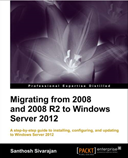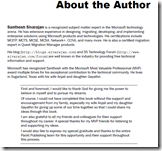Windows Server 2012- Migration from Windows Server 2008 to Windows Server 2012



Publisher
PACKT Publishing
Product Details
- Paperback: 84 pages
- Publisher: Packt Publishing (January 23, 2013)
- Language: English
- ISBN-10: 1849687447
- ISBN-13: 978-1849687447
- Product Dimensions: 9.2 x 7.3 x 0.3 inches
- Shipping Weight: 7.2 ounces
Table of Contents
- Preface 1
- Instant Migration from Windows Server 2008 and 2008 R2 to 2012 How-to 7
- Installing Windows Server 2012 (Must know) 9
- Converting Server Core to Server with a GUI (Should know) 12
- Converting Server with a GUI to Server Core (Should know) 13
- Configuring Windows Server 2012 (Must know) 15
- Installing administration tools (Must know) 19
- Working with Server Manager properties (Should know) 21
- Adding servers to Server Manager (Should know) 23
- Creating server group (Should know) 25
- Enabling remote desktop (Should know) 26
- Add and remove roles and features (Must know) 28
- Active Directory migration (Must know) 29
- FSMO role transfer/migration (Must know) 39
- Windows Server Migration Tools (Must know) 43
- Dynamic Host Configuration Protocol (DHCP) migration (Must know) 45
- DNS migration (Should know) 50
- Data and file server migration (Must know) 53
- Printer and print server migration (Must know) 57
- Hyper-V migration (Should know) 64
- Decommissioning old domain controllers (Must know) 68
- Forest and domain functional level (Must know) 68
What this book covers
- Installing Windows Server 2012 (Must know), provides step-by-step instructions on installing Windows Server 2012 Server Core, Windows Server 2012 Server with a GUI, and Server Core to Server with a GUI and vice versa.
- Converting Server Core to Server with a GUI (Should know), introduces methods using Windows PowerShell for converting Windows Server 2012 Server Core into Windows Server 2012 Server with a GUI.
- Converting Server with a GUI to Server Core (Should know), provides methods using Windows PowerShell for converting a Windows Server 2012 Server with a GUI into Windows Server 2012 Server Core. This recipe also provides a method for identifying different types of Windows Server 2012.
- Configuring Windows Server 2012 (Must know), provides an overview of Window Server 2012 Server Manager, performing administration tasks such as changing the computer name, joining a computer to a domain, and so on using Server Manager. It is also provides the details of administering a Windows Server 2012 Server Core using sconfig utility.
- Installing administration tools (Must know), explains the details of installing Remote Server Administration Tools and new features available in Windows Server 2012 for managing and administering remote or local servers. This recipe also covers some of the deployment tasks that are relevant for migrating Windows Server 2008/R2 to Windows Server 2012.
- Working with Server Manager Properties (Should know), introduces the Server Manager dashboard and its capabilities for an administrator to efficiently manage the servers. This recipe also provides the details and capabilities of new Server Manager.
- Adding servers to Server Manager (Should know), describes how multiple servers can be managed from the Server Manager dashboard and explains the details of adding a server to Server Manager from Active Directory, DNS, and using an import file.
- Creating a server group (Should know), introduces the new server group concept, from where you can now manage and administer local and remote servers based on roles, features, or custom categories. This recipe provides step-by-step instructions on creating, managing, and modifying the group.
- Enabling remote desktop (Should know), describes the new Server Manager's capabilities of remotely managing multiple servers. In certain instances, the administrators have to remotely log in to these servers using remote desktop connection. This recipe provides details of enabling and disabling remote desktop options.
- Add and remove roles and features (Must know), introduces additional roles and features which can be deployed onto local or remote machines using the new Server Manager. In this recipe, we will explain a procedure to remove roles and features.
- Active Directory migration (Must know), provides the details of Active Directory migration prerequisites, schema upgrade procedure, verifying the schema version, and installing the Windows Server 2012 Domain Controller in the existing Windows Server 2008 and Server 2008 R2 domain.
- FSMO role transfer/migration (Must know), introduces some of the features of Windows Server 2012 that are only available when the FSMO role is running on the Windows Server 2012 Domain Controller. This recipe provides the details of these new features and also provides step-by-step instructions on transferring FSMO roles using PowerShell cmdlet and Windows Server Administration Tools.
- Windows Server Migration Tools (Must know), provides you an overview of Windows Sever Migration Tools, PowerShell cmdlets details, installation instructions, and step-by-step instructions on creating an installation package for different types of servers.
- Dynamic Host Configuration Protocol (DHCP) migration (Must know), explains the procedure for migrating DHCP scope and lease information using Windows Server Migration Tools. DNS migration (Should know), provides the details of different types of DNS zones, zone replication details, and migration zones using secondary to primary conversion method and the dnscmd command.
- Data and file server migration (Must know), describes how the file server or data migration can be achieved by migrating the data from the existing server onto a new server. In this recipe, I will be explaining a migration procedure using Windows Server Migration Tools cmdlet such as Send-SmigServerData and Receive-SmigServerData.
- Printer and print server migration (Must know), provides details of migrating printers and associating its properties using the Print Management console. This recipe also provides instructions on installing Print and Document Services role onto Windows Server 2012.
- Hyper-V migration (Should know), explains a couple of procedures for migrating Hyper-V guest machines from Windows Server 2008 and Windows Server 2008 R2 to a new Windows Server 2012 Hyper-V server.
- Decommissioning old domain controllers (Must know), provides step-by-step instructions on uninstalling an existing Windows Server 2008 and 2008 R2 Domain Controller.
- Forest and domain functional level (Must know), introduces some of the new Windows Server 2012 features that will only be available when the forest or domain functional level is set to a certain state. This recipe provides details of these new features, raising and lowering domain and forest functional levels, and verifying the functional level using directory services commands.
Overview
A step-by-step guide to installing, configuring, and updating to Windows Server 2012.
- Learn something new in an Instant! A short, fast, focused guide delivering immediate results.
- Install and configure Windows Server 2012 and upgrade Active Directory.
- Decommission old servers and convert your environment into the Windows Server 2012 native environment.
- Walks you through different migration scenarios based on the author's own experience, providing a step-by-step guide to solving real-world business problems.
In Detail
Migrating to a new server involves a lot of decision making and planning. Windows Server 2012 comes with exciting new features and ease of use. This book will help you migrate to your new server in no time.
"Instant Migration from Windows Server 2008 and 2008 R2 to 2012 How-to" provides you with many practical and real world scenarios in a step-by-step guide. It is designed to lead you through the entire process of migration.
Beginning with an introduction to Windows Server 2012, the author then takes you through the installation and configuration of the server, before continuing on to migrate the existing services to Windows Server and how to decommission old servers.
The "how-to" migration scenarios described are based on the author's own field experiences, guaranteeing real-world solutions. The scenarios include Active Directory, enabling a Remote Desktop, Print Server, and Hyper-V migration details.
From the planning to the implementation phase, "Instant Migration from Windows Server 2008 and 2008 R2 to 2012 How-to" is your comprehensive guide for completing migration solutions.
What you will learn from this book
- Install and configure the Windows Server 2012.
- Learn the administration of Windows Server 2012.
- Master Active Directory Migration, DNS Migration, and DHCP Migration.
- Follow step-by-step instructions on data and file server migration.
- Learn about printer and print server migration.
- Discover how to implement Hyper-V migration.
- Explore Infrastructure services (DNS, DHPC, and so on) and File and Printer server migration scenarios.
Approach
Filled with practical, step-by-step instructions and clear explanations for the most important and useful tasks. Get the job done and learn as you go. Presented in a hands-on reference manual style, with real-world scenarios to lead you through each process.
Who this book is written for
This book is intended for Windows server administrators who are performing migrations from their existing Windows Server 2008 / 2008 R2 environment to Windows Server 2012. The reader must be familiar with Windows Server 2008.





















